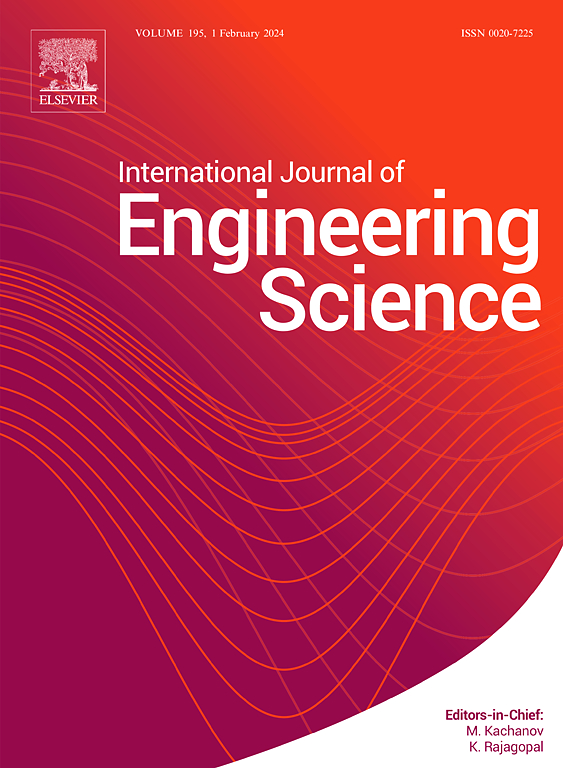Orientation and shear mechanisms of finite deformation of the cell cytoskeleton
IF 5.7
1区 工程技术
Q1 ENGINEERING, MULTIDISCIPLINARY
International Journal of Engineering Science
Pub Date : 2025-05-15
DOI:10.1016/j.ijengsci.2025.104306
引用次数: 0
Abstract
This study presents a novel statistical-thermodynamic framework to model the finite deformation of the eukaryotic cell cytoskeleton, emphasizing the roles of actin filament orientation and bundle sliding. By introducing internal variables, such as an orientation order parameter and a microshear strain, the model captures the nonlinear mechanical response of the cytoskeleton under shear stress, including finite strain and critical damage dynamics. The free energy of the system is derived as a function of these variables, temperature, and a structural parameter that acts as an "effective temperature," reflecting the cytoskeleton's susceptibility to mechanical reorganization. Numerical simulations reveal distinct deformation regimes, from orientation ordering stage to failure, governed by the structural parameters. The results provide insights into the mechanobiology of cells, with potential applications in understanding pathological conditions and designing tissue engineering scaffolds.
细胞骨架有限变形的定向和剪切机制
本研究提出了一个新的统计-热力学框架来模拟真核细胞骨架的有限变形,强调肌动蛋白丝取向和束滑动的作用。该模型通过引入取向序参数和微剪切应变等内部变量,捕捉细胞骨架在剪切应力作用下的非线性力学响应,包括有限应变和临界损伤动力学。系统的自由能是这些变量、温度和作为“有效温度”的结构参数的函数,反映了细胞骨架对机械重组的敏感性。数值模拟揭示了不同的变形机制,从取向有序阶段到破坏,由结构参数控制。这些结果为细胞的力学生物学提供了新的见解,在理解病理条件和设计组织工程支架方面具有潜在的应用价值。
本文章由计算机程序翻译,如有差异,请以英文原文为准。
求助全文
约1分钟内获得全文
求助全文
来源期刊

International Journal of Engineering Science
工程技术-工程:综合
CiteScore
11.80
自引率
16.70%
发文量
86
审稿时长
45 days
期刊介绍:
The International Journal of Engineering Science is not limited to a specific aspect of science and engineering but is instead devoted to a wide range of subfields in the engineering sciences. While it encourages a broad spectrum of contribution in the engineering sciences, its core interest lies in issues concerning material modeling and response. Articles of interdisciplinary nature are particularly welcome.
The primary goal of the new editors is to maintain high quality of publications. There will be a commitment to expediting the time taken for the publication of the papers. The articles that are sent for reviews will have names of the authors deleted with a view towards enhancing the objectivity and fairness of the review process.
Articles that are devoted to the purely mathematical aspects without a discussion of the physical implications of the results or the consideration of specific examples are discouraged. Articles concerning material science should not be limited merely to a description and recording of observations but should contain theoretical or quantitative discussion of the results.
 求助内容:
求助内容: 应助结果提醒方式:
应助结果提醒方式:


